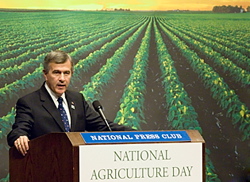 It’s almost National Agriculture Day and in anticipation U. S. Secretary of Agriculture Mike Johanns held a press conference yesterday. He’s seen here at the Kick-off for National Ag Day at the National Press Club. You might be interested to see what he had to say. In his speech he spent some time talking about the farm bill and the barriers to getting into farming. Here’s an excerpt on this subject:
It’s almost National Agriculture Day and in anticipation U. S. Secretary of Agriculture Mike Johanns held a press conference yesterday. He’s seen here at the Kick-off for National Ag Day at the National Press Club. You might be interested to see what he had to say. In his speech he spent some time talking about the farm bill and the barriers to getting into farming. Here’s an excerpt on this subject:
Now, one thing I heard loud and clear from you during the Farm Bill Forums was: there’s a great deal of interest in entering farming. But the barriers these days to young people, we were told, were still very high. I am aware of the financial burden facing young farmers. A combine goes for over $200,000. Tractors don’t cost much less. National farmland values have increased 65 percent in the last five years to an average of $1,900 an acre, and in some parts of our country much, much higher.
I don’t know about you, but when I was your age I’ll guarantee you I did not have that kind of money saved up.
So our proposals are designed to help beginning farmers overcome those hurdles. Think about this: We propose giving beginning farmers a 20 percent increase in the direct payment. This will add about $250 million to their income over the next decade if that proposal is adopted on Capitol Hill. I’m also aware that beginning farmers and ranchers are often less familiar with support in the form of conservation programs. What’s more, the typical beginning farmer owns a smaller operation of 50 acres or less, which isn’t always competitive when applying for conservation support.
So to increase our aid and encourage good conservation practices, we propose setting aside 10 percent of our conservation assistance to be used only for beginning farmers and socially disadvantaged farmers. Our Beginning Farmer and Rancher Downpayment Loan Program was designed to encourage young farmers to enter agriculture. But it hasn’t been as successful as we would like. I heard your concerns again, your concerns that the interest rate is too high and the loan cap too low to buy commercially viable land.
So we listened, and we proposed to rectify that situation in the proposals we sent up. By cutting the interest rate in half to 2 percent, deferring the initial payment for a full year, and increasing the maximum loan value to $200,000 we would also decrease the minimum beginning farmer contribution from 10 percent of the property purchase price to 5 percent. We would increase the direct ownership and direct operating loans from the current level of $200,000 each to $500,000 for any combination of those two loan types.
And we would help beginning and minority farmers purchase their first spread by giving them first priority. First priority for all direct farm ownership loans.
I believe these changes will make it easier for young farmers to get into farming. Agriculture is vital to our nation’s success, and the cost of entering the field should not be prohibitive to eager young farmers. Now, I hope that those of you who are interested will take advantage of these programs and begin your own operations.
